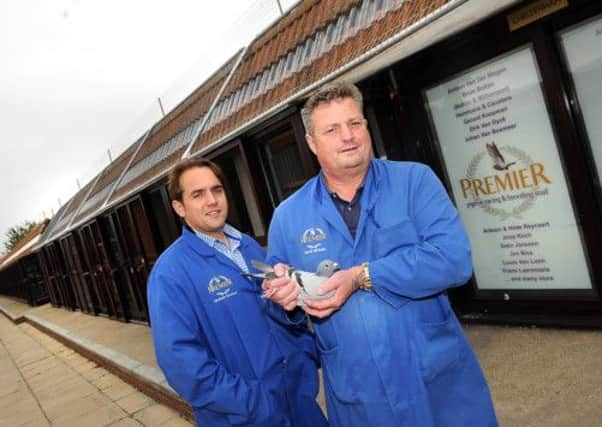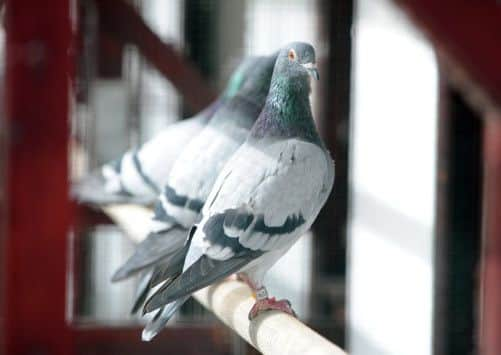Homing in on a high flying trade


Derek Nicholls has spent his life focusing on the flight paths of racing pigeons. He has also done a fair bit of long-distance flying of his own.
“I’m the only man who has been to Beijing on a day trip,” he says. “I arrived on the Saturday and came back on the Sunday.”
Advertisement
Hide AdAdvertisement
Hide AdThose two facts are connected. The Chinese have always liked a flutter and since the demise of Communism their fascination with top-class racing pigeons has soared. China is now the richest global racing pigeon market and the asking prices for the birds are so high – Derek’s Beijing excursion involved a five-figure order – it makes sense for him to deliver them to the buyer in person.


His obsessive attention to detail, and readiness to embark on a 24,000-mile round trip to the Chinese capital to keep the elite birds company, impressed the locals. Word got around among the country’s high-rolling pigeon fanciers and prompted further orders from East Yorkshire.
“Going in person did us the world of good in China,” said Derek. “We sold 100 birds there last year. We’ve been selling over there for about six years. In terms of money it’s the biggest market in the world.”
He is the managing director of the Premier Racing Pigeon and Breeding Stud which is attached to the Patrington Haven Caravan and Leisure Park that lies out in the flatlands of Holderness east of Hull. It’s one of only two studs operating on this scale in the country and is among the top 10 in the world. The immaculate lofts hold more than 2,000 birds and they have others in Antwerp, the world centre for racing pigeon auctions.
Advertisement
Hide AdAdvertisement
Hide AdThe lofts here are a world away from those rickety, make-do-and mend structures that you once saw on allotments dotted around the country. The birds that make up the elite of the elite at Patrington have a separate unit of their own and receive the equivalent of five-star treatment.
The stud is probably holding 1,000 for sale and during the week we visited they had gone to Romania and California as well as more to China.
This is not the only corner of East Yorkshire profiting from an insatiable Far East demand for our top flyers. Or even celebrity non-flyers. Champion Treble Six, a six year-old racing pigeon from Bridlington – nicknamed The Banker because of the regularity of its victories – was permanently grounded after a wing injury.
Yet a Chinese buyer was still prepared to pay what was then believed to be a British record of £16,000. Champion Treble Six’s owner, Kerry Mellonby, had kept it to breed further champions and the winning bloodline was why the Chinese paid top dollar at auction.
Advertisement
Hide AdAdvertisement
Hide AdThis Chinese fascination with fast pigeons began with the Ming emperors of the 14th-century. The sport was banned during the Cultural Revolution but has bounced back in recent times among the affluent for whom owning racing pigeons is a status symbol. The greatest symbol of all is a bird called Bolt (named after Usain Bolt). The world’s most expensive pigeon was bred by a Belgian fancier. On retirement a few months ago he sold it to a Chinese businessman for £260,000.
It’s a world away from that sporting trinity of pigeon racing, cloth caps and whippets that once dominated British working class social life.
It was in Leeds that early enthusiasts gathered with a view to giving it a formal status in March 1896. At the White Swan in the city’s Call Lane they formed the National Homing Union (now the Royal Pigeon Racing Association) to regulate the sport.
Derek Nicholls started out with pigeons in Cardiff in 1967 – under his grandfather’s instruction. “As a boy I saw them come back from exotic places and I thought, ‘how does that work?’”
Advertisement
Hide AdAdvertisement
Hide AdFor veterans moulded in harsher times, the sport came second to more pressing needs, like eating.
“After the war the interest in pigeons was for eggs and for meat,” says Derek. “For me, one grandfather was Mr Pigeon, the other grandfather was Mr Rabbit. I thought there were only two sorts of meat that a family ate, rabbit and pigeon.”
This unsentimental approach applied to any animal in the household. Derek recalls an episode when his grandfather saw his pet dog run over by a tram in Cardiff. He earned the admiration of onlookers when he lifted the broken animal from the tracks to carry home. But he was taking it back to put in the boiler to feed to the pigs. You couldn’t afford not to.”
Grandfather’s pigeon training regime was to take them to the local railway station from whence they were carried to the top of the valley and handed to the station master at Merthyr Tydfil to release. On the afternoon of our visit to the Patrington lofts, Derek is about to send some of his birds by road to Market Rasen for a training spin.
Advertisement
Hide AdAdvertisement
Hide AdThe cocks’ competitive season had already closed. These hens would be racing to the end of September. What does an afternoon outing achieve? “It’s half an hour to polish up their navigational skills – very important in races in the run-in.”
What makes these different from the pigeons we know and hate in town centres? “These are the result of 25 years of selective breeding, discarding the idiots and those that are too slow.”
Pigeons are monogamous and live up to ten years. By using foster parents, a pair can produce 20 chicks a year. Under normal conditions, it’s half that rate. They are the fastest maturing bird in the world, doubling in size in 24 hours and progressing from tiny hatchling to flying in 24 days.
The selling year starts in October. The most they have paid at the stud is £110,000. The highest price they have sold a pigeon for was £36,000. Two years ago they sold a bird for £65. They bought it back for £21,000 after it won 11 races. “Not one of our better deals,” says Guy. “If it continues to do well, the value is there.”
Advertisement
Hide AdAdvertisement
Hide AdAt the stud they focus on breeding middle distance birds. “Shorter races can be influenced by wind and weather, longer ones by luck.” They go faster these days because of predictive modern technology, meaning they are let go in better weather conditions.
Domesticated pigeons are distant descendents of the rock dove whose first human links are lost in the mists of time. Roman historians noted them in 43BC. How they navigate in not fully understood. The Earth’s surface has magnetic contours and it’s widely believed the pigeons follow these. They also use the sun.
In the old days, when a pigeon arrived in its home loft at the end of a race, a runner had to be on hand to carry the ring from its leg to the point of verification. Urgent leg work at the end of a race is no longer needed. Today bar codes and electronic point of sale systems used in supermarkets make runners redundant.
This site was once an RAF camp. Businessman Graham Sparkes bought the RAF land from the Ministry of Defence in 1985 and converted it into a caravan park which has since won awards.
Advertisement
Hide AdAdvertisement
Hide AdThe pigeon connection came about through one of its many West Yorkshire customers who inquired if it were it possible to have a pigeon loft with his caravan. Graham Sparkes decided against. But as a one-time enthusiast for the sport it suggested a new business opportunity.
Graham’s son Guy has developed the pigeon stud and recruited Derek, a former docker, who left that job when he was offered a £26,000 pay-off. What did he do with the money? “Bought pigeons.”
As a self-employed pigeon-breeder, he was selling 200 a year at £100 each. Now the average is £3,000. Breeding and racing a winner means big prizes. Derek was second in a million dollar race in South Africa and won £120,000. He became friendly with the late Carlo Napolitano, the manager of the Queen’s racing pigeon lofts on the Sandringham estate.
Derek Nicholls regrets pigeon racing no appeals to the masses. “For youngsters of the xBox generation the interest is not as strong as 20 years ago. But then it is not as easy to keep livestock in your own house as it used to be.”